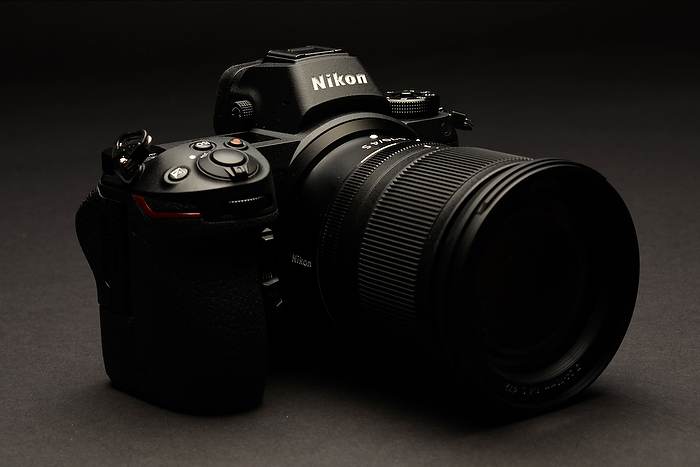I’ve had a Nikon Z7 for a few weeks now, and will start off by saying I’m really impressed with it. Aside from the Coolpix line, Nikon had only dabbled in mirrorless cameras with the V and J-series a few years ago. As a long-time Nikon School instructor, I can’t tell you the number of times I’ve heard the question, “Is Nikon just going to ignore this new market?” My answer was always the same: “No. I think they’re simply waiting for the technology to reach the point where they can make a mirrorless camera that lives up to their brand.“ And the Z7 is just that. Reviewers have described it as a mirrorless D850. But while it shares the same resolution and many of the same features, it’s truly an entirely different camera. Is it, or its sibling the Z6 right for you? That’s what I hope this story will help you decide.
This is not a technical review. There are plenty of those already, and my guess is if you’re reading this, you’ve already read some of them. So if you’re reading this, then it’s probably because you’ve attended a seminar or workshop I’ve taught, and know that I’ll give you my honest opinion. During the time I’ve been shooting this camera, I’ve kept notes that break my experience down into a few categories. I’ll start with the pros and cons. I have yet to use any camera (Nikon or other) that was perfect, so I didn’t expect Nikon’s first serious effort in this area to hit a homerun. But I think it’s fair to say that they’ve probably hit at least a triple, which is impressive in itself.
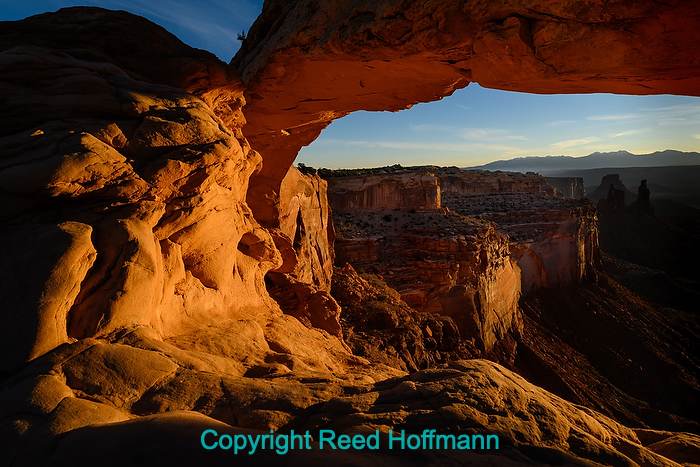
Through the viewfinder, I was able to dial in a -.7 exposure correction and know that it was right for this sunrise shot at Mesa Arch. Seeing the changes to exposure and color as you’re making them, before taking the picture, in the viewfinder, is, to me, the greatest single advantage to an electronic viewfinder camera. Nikon Z7, Aperture Priority, ISO 100, 1/40 at f/16, -0.7 EV, Nikkor AF Zoom 18-35mm f/3.5-4.5G lens at 18mm.
Pros
– WYSIWYG (What You See Is What You Get) – in my opinion, this is the single most important feature of a mirrorless camera. With an electronic viewfinder, you can actually see what happens as you shift exposure and white balance. But, it has to be accurate, and not all mirrorless cameras are. I quickly found that I could trust what I was seeing in the Z7’s viewfinder, which meant I was doing much less guessing about exposure. And that also means I spent less time (and battery) checking photos I’d just shot. This is a big deal.
– Ergonomics – I’ve always preferred larger cameras because they could have more buttons and dials, which meant I could make changes more quickly while shooting. So a smaller body had me worried I’d lose that. And here’s where I have to give big kudos to the design team behind this camera. Any Nikon user who picks one up will feel right at home. Not only does the grip feel solid and easy to hold, but most of the key buttons and dials are right where a Nikon user would expect them to be. And, for those buttons that we lost, the “i” button on the back of the camera gives you instant access to twelve (12!) features. Plus, you can program that panel to give you pretty much any twelve things you want to change. This is similar to a feature Nikon’s had on their entry-level cameras for some time, and a great solution to fewer buttons. Plus, Nikon’s added two large Function buttons on the front of the body, which can also be programmed. And I want to put out a special “thank-you” to whoever on the design team chose to make those buttons bigger. On my camera, those two buttons are now programmed to take me to “My Menu” or turn on the preview of the photo I’ve just taken. That lets me look at it without taking the camera down from my eye.
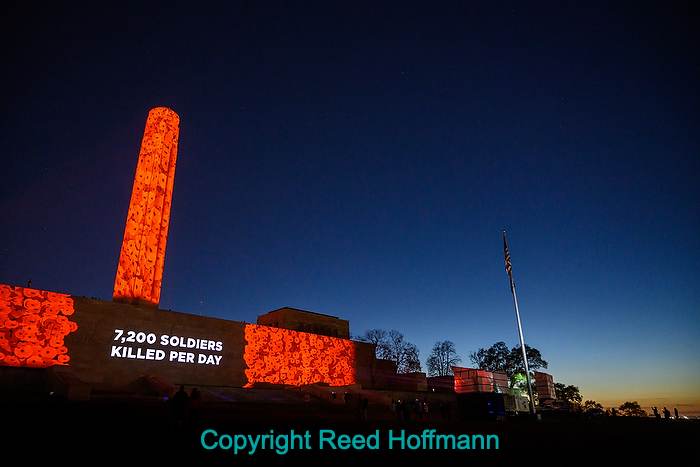
Normally for a photo with this little available light, I’d have needed a tripod. But thanks to the excellent built-in stabilization of the Z7, I shot this hand-held, at 1/10 second, and it’s tack sharp. Nikon Z7, Aperture Priority, ISO 5000, 1/10 at f/4, -1.3 EV, Nikkor AF Zoom 24-70mm f/4 lens at 24mm.
– In Body Image Stabilization (IBIS) – With the mirror gone, Nikon added 5-axis image stabilization to their sensor, which gives you five-stops of stabilization. Now of course, those five stops are heavily dependent on how steady you are at holding the camera. And, that’s with a new Z-mount lens. But you also get some added stabilization when using one of the F-series lenses. Better yet, you gain pitch and roll stabilization with both VR lenses and lenses that don’t have VR. So that’s helps with non-Z mount lenses, which is a nice benefit. There were many times I shot hand-held at slower shutter speeds than I ever would have in the past, and could leave my tripod behind in the car for several hikes around Moab. With a smaller camera body you’re talking about shaving ounces off your kit. Skipping the tripod saves you pounds!
– Nikkor Z 24-70mm f/4 lens –I was surprised at how much I liked this new lens. As a fan of the 24-120mm angle of view from Nikon’s FX and DX (16-80/85mm DX) lenses, I was disappointed the lens released with the camera didn’t match that focal length. But this lens follows through on Nikon’s promise of even better optical performance through the larger Z mount. Center sharpness is there, of course, but edge sharpness wide open (at f/4) is a true test of how well designed a lens is, and this one delivers.
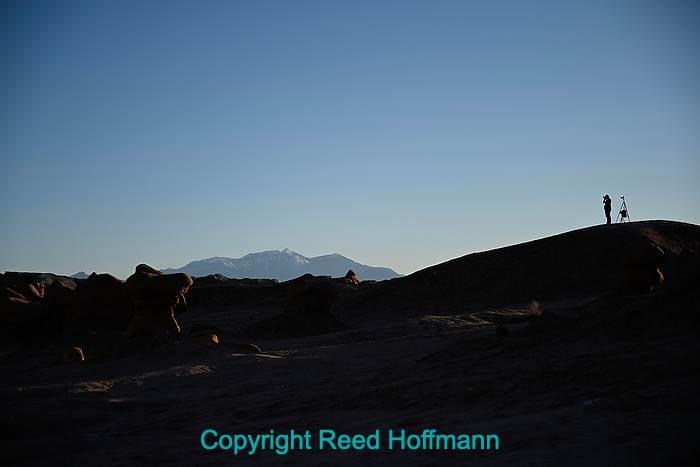
I shot this wide-open at f/4 with the new 24-70mm. Note the man and tripod at the far right, then look at the zoomed view below. Nikon Z7, Aperture Priority, ISO 64, 1/1000 at f/4, -1.0 EV, Nikkor AF Zoom 24-70mm f/4 lens at 70mm.
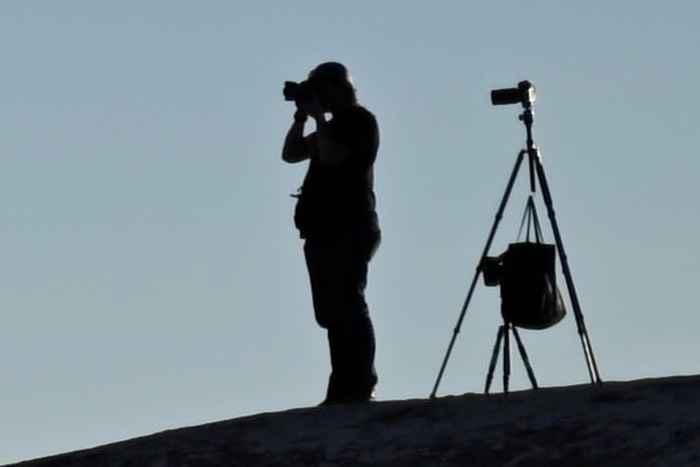
This is a 100% zoom to that area of the photo. Note that despite how small the subject is in the original photo, there’s a tremendous amount of detail in this zoomed, 1:1 view.
– Mode dial – Some photographers have complained that Nikon put a mode dial on the left shoulder of the camera. I applaud that. The functions that used to be there on my other high-end Nikons are now under the “i” button, and with this change, Nikon added one of my favorite features from the D7XXX cameras (and D750) to their high-end cameras: custom User sets. Having three of those means I can now easily switch between my standard way of shooting (1) to night photography (2) to video (3) without having to make loads of changes to menus and buttons. If your camera offers these (two in earlier cameras) and you haven’t tried them yet, you’re missing out.
– Zoom in EVF and Focus Peaking – Now that I’ve got an EVF, I can hit the + button with my thumb and zoom in to check focus before shooting. And, in Manual focus mode, I get “Focus Peaking,” which makes manually focusing much easier, and helps me confirm focus.
– FTZ adapter – I’ve used a bunch of my F-series Nikkor lenses on the Z7 already, thanks to this adapter, and it’s worked flawlessly. My only complaint here is that I’m going to need a second one, so I don’t have to constantly be swapping it between those lenses!
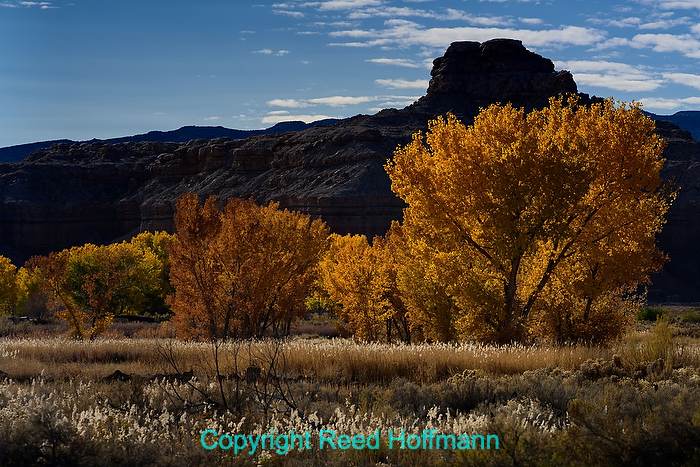
One of many photos I shot with several different F-mount lenses and the FTZ adapter. I ran into no issues, either in focus performance or sharpness. Nikon Z7, Aperture Priority, ISO 125, 1/500 at f/6.3, -1.0 EV, Nikkor VR Zoom 70-200mm f/2.8 lens at 200mm,.
– Size – Note that I left this for the end. Yes, I’d love smaller and lighter cameras. And this camera is. But as long as I prefer larger sensors, that means I’ll still have fairly large lenses. There’s a really good reason Nikon didn’t introduce these cameras with a 24-70mm f/2.8 or 24-120mm f/4 lens. They would have made the whole package bigger and heavier, and photographers have been screaming for smaller and lighter. And let me tell you, that 24-70mm f/4 Z-series lens is SHARP. And, fairly compact too. Plus, bought as part of the package, a real deal.
Cons
– Electronic Viewfinder (EVF) – Bright, clear, crisp. The viewfinder is as good as or better than any other top-of-the-line mirrorless camera I’ve handled (and I’ve used most of them). Is it perfect? No. I still prefer the clearer view I get with my mirrored cameras for some things, like night photography. But this isn’t a deal breaker for me, as it’s still very, very good. Also, I think the advantages it offers (see “Pros” above) usually outweigh the disadvantages. But it’s still not the same look you get with a mirror. That’s probably the biggest adjustment a new user will have to make.
– Smaller body – Yes, smaller can be good, but for those with big hands, the fit may not be great. I’ve had to adjust how I automatically reach for the +/- and ISO buttons on top, as they’re now closer to the shutter button.
– Night photography –If you’re out under just stars, you probably won’t be able to see anything with the EVF or the LCD. You can still zoom in on a star to focus, but framing is “shoot and adjust.” Point the camera where you think the framing should be and shoot, then check and adjust. On the plus side, the virtual horizon indicator at least lets you make sure the camera’s level. The Nikkor 20mm f/1.8 is my primary night photography lens, mostly because that f/1.8 aperture lets enough light in, even when under just stars, for me to frame using a mirrored camera. The Z7’s EVF can’t quite match that. Yet.
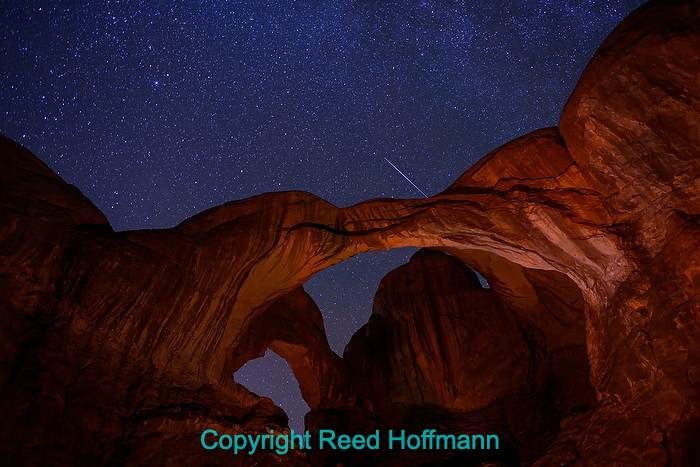
The sharpness, and low noise at high ISO were very pleasing to see in my night photography. But you do have to shoot a few photos and guess at framing to get started, due to the inability to see anything through either the viewfinder or the LCD under just starlight. Thankfully, the virtual horizon indicator helps make that a lot easier. Nikon Z7, Manual exposure, ISO 2000, 30-seconds at f/2.2, Nikkor AF 20mm f/1.8G lens.
– When you take the lens off the body, that’s the sensor you’re looking at. No mirror, no shutter covering it. So it’s much easier to get dust on it, which means you need to blow it off more frequently. On the plus side, since it’s right there, it’s easy to quickly clean with a hand blower.
– One card slot – People have been losing their minds over this, so I have to mention it. However, I’ve always set my second card slot for overflow, not backup. And I’ve never had a card failure. So it’s not really an issue for me, and I do understand that adding a second slot would have meant a slightly larger body. So there.
– 3D AF – Over the last couple of years I’ve become a big fan of Nikon’s 3D AF Area Mode. While it’s still there in the Z-series cameras, it now takes two button pushes to use it. I know that changing to mirrorless meant a huge change to the autofocus system, so I’m expecting that Nikon will continue to improve this and make 3D easier going forward.
Other
– Nikon has a new battery for the Z-series, the EN-EL15b, which gives better battery life than the original EN-EL15. Despite fairly low CIPA ratings, I haven’t shot the new battery dead yet (shooting nearly 100o images) and even shot over 500 frames with the older battery. While that same older battery will give me more frames in a mirrored Nikon, I do understand that an EVF camera will draw more power. And, I expect that as I continue to use the camera, I’ll find other ways to reduce energy use (for instance, right now I’m leaving SnapBridge connected to the camera). Bottom line, I’m willing to trade fewer shots on the Z7 than my other cameras in return for being able to use the same battery in all of them (the older EN-EL15 is used in MANY Nikons). Using the same battery (and charger) across many cameras is much more important to me.
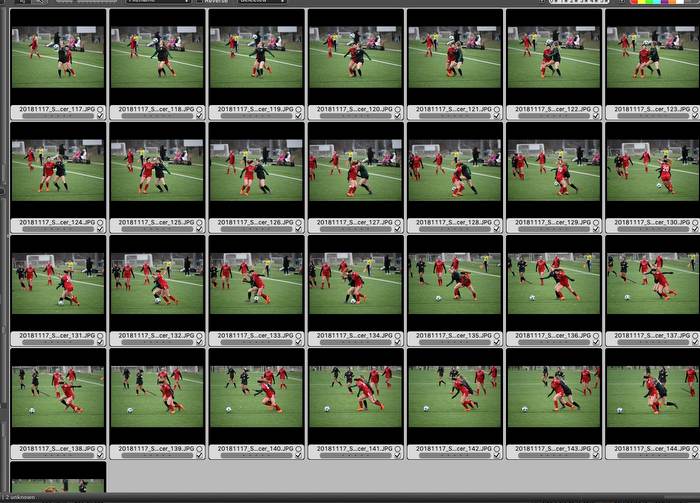
In this 29-frame sequence, shot with the Z7, FTZ adapter and Nikkor 200-400mm lens wide open (f/4), there were only four frames out of focus.
– I’ve only done a little action photography with the camera, shooting a soccer game with my Nikkor 200-400mm f/4 lens at f/4, with the FTZ adapter. I used both Continuous High (5.5 frames per second) and Continuous High (extended, 9 fps), and the AF Area Mode set to Wide-area AF (S, for small area). That mode is supposed to be similar to the “Group” AF-Area Mode I’m used to on the other Nikon cameras I shoot and what I would normally choose for soccer. The autofocus system did a very nice job of grabbing focus and staying on the subjects as they moved. I’ll need more time to experiment with action and this new autofocus system, but so far it’s looking very promising, and I didn’t notice any degradation in performance using the FTZ adapter.
– I’ve read complaints that certain tripod plates don’t work well on the Z7. The small Arca Swiss ones I use had no issues, and I’ve noticed that several companies have announced they’re designing new plates for this camera.
– I’m very happy Nikon included a top display on this camera (OLED, no less), since some mirrorless cameras don’t have one. Again, there have been some complaints that it doesn’t show as much information as a traditional Nikon top display, but again, I don’t have a problem with that. It shows shutter speed, aperture, battery life, ISO, frame rate and frames remaining, and is easily visible in bright light. That works for me.
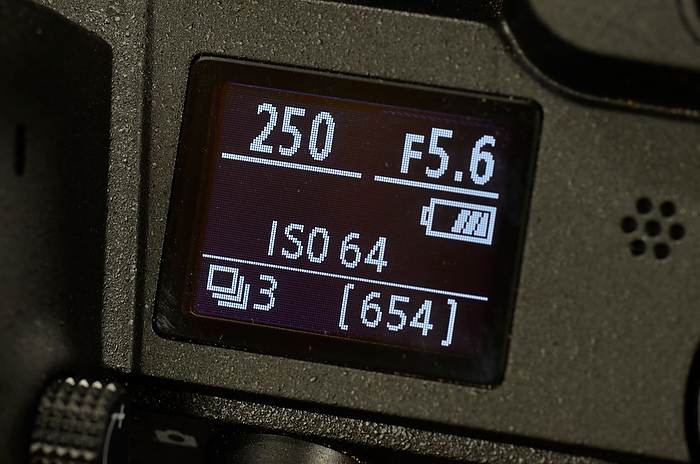
The OLED top display on the camera gives me all the information I need to see there.
– I saw one online review where the photographer complained a great deal about how the door to the card slot seemed to pop open at the slightest bump. He described it as a serious flaw. Maybe there was something wrong with his camera, but the door on mine has yet to come open by accident.
Adjustments
Now that we’ve gotten those out of the way, let’s look at what’s really important – what kind of adjustments I’ve needed to make to how I shoot while using this camera:
– EVF/camera wake-up – Having spent most of my life using a mirrored camera, if I see something that might make a picture, I pull the camera up and look at that scene through the viewfinder. Before, I could do that without turning the camera on. Now I have to wake the camera up or turn it on. It’s a minor annoyance right now, but I’ll adjust to it.
– Manual exposure – I’m a big fan of Aperture Priority as my go-to exposure mode, for a number of reasons. But now that I can see exactly what’s happening to exposure through the viewfinder, I find myself shooting Manual exposure more often. I often set my aperture between f/5 and f/8.0, and I still do that. But instead of adjusting +/- exposure compensation, I’m now dialing the shutter speed up or down. I’m liking that because once I get the exposure I like, I don’t have to adjust +/- as the quantity of light and dark in the scene changes with my changes in framing.
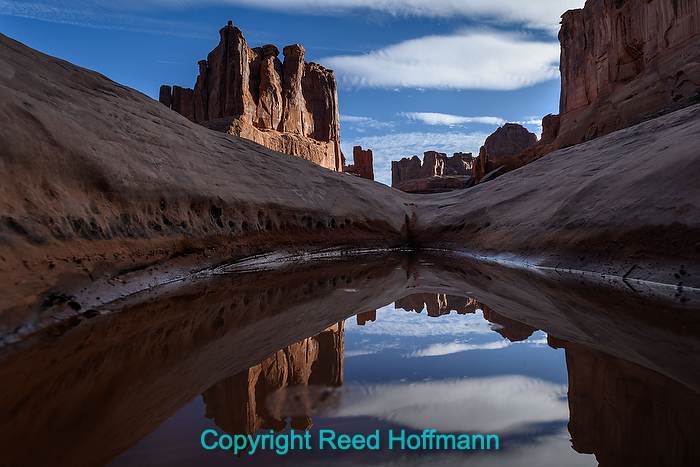
With Manual exposure and an accurate viewfinder (or LCD, in this case), I’m spending much less time bracketing as I shoot. And finally, I have to say how much I like having an articulated LCD on this camera and many of the new models. That allows me to get the camera low (in this case nearly in the water) and still be able to frame accurately. Nikon Z7, Manual exposure, ISO 125, 1/125 at f/10, Nikkor AF Zoom 18-35mm f/3.5-4.5G lens at 20mm.
– Virtual Horizon indicator – On the recent workshop I taught in Moab, I left the virtual horizon indicator in the viewfinder turned on almost the entire time. Shooting mostly landscapes, it really helped me keep my horizons straight. My only complaint is that it’s fairly large, bright and in the center of the viewfinder, so a bit distracting. I hope Nikon offers a kinder, gentler version in the future.
– Live Histogram –if I wasn’t using the virtual horizon, it was because I had the live histogram on in the viewfinder instead. I really like how Nikon implemented this. It’s small and in the lower right corner, so rarely interferes with my view.
– IBIS – I mentioned this above already, but it’s worth mentioning again. Having better stabilization let me shoot at lower ISOs and lower shutter speeds, hand-held, and also let me skip carrying the tripod all the time. That takes weight off my back.
Conclusions
As you can probably tell, I’ve been very impressed with this camera, although I know there’s still more to learn. I’ve only shot a little action so far, and there are a number of new features I’ve yet to explore. But mirrorless is the future of photography, and I’m going to embrace it. Does that mean I’ll get rid of my mirrored cameras? No. They still offer certain advantages. When Nikon introduced full-frame sensor cameras (FX), I didn’t get rid of my DX cameras. Instead, I carried one of each, to be able to play to each one’s strengths. And that’s just what I’ll be doing now. Carrying a mirrorless Nikon and a mirrored body, using each for what it does best. And when the time comes for me to put that last mirrored body away, it will join my first Nikon, a Nikkormat FTN bought in 1974, on a shelf with my other treasured old cameras.
(If you like this story, please share it with your friends and let them know about the links on photography I post on my business Facebook page. I’m also on Instagram and Twitter, @reedhoffmann)

